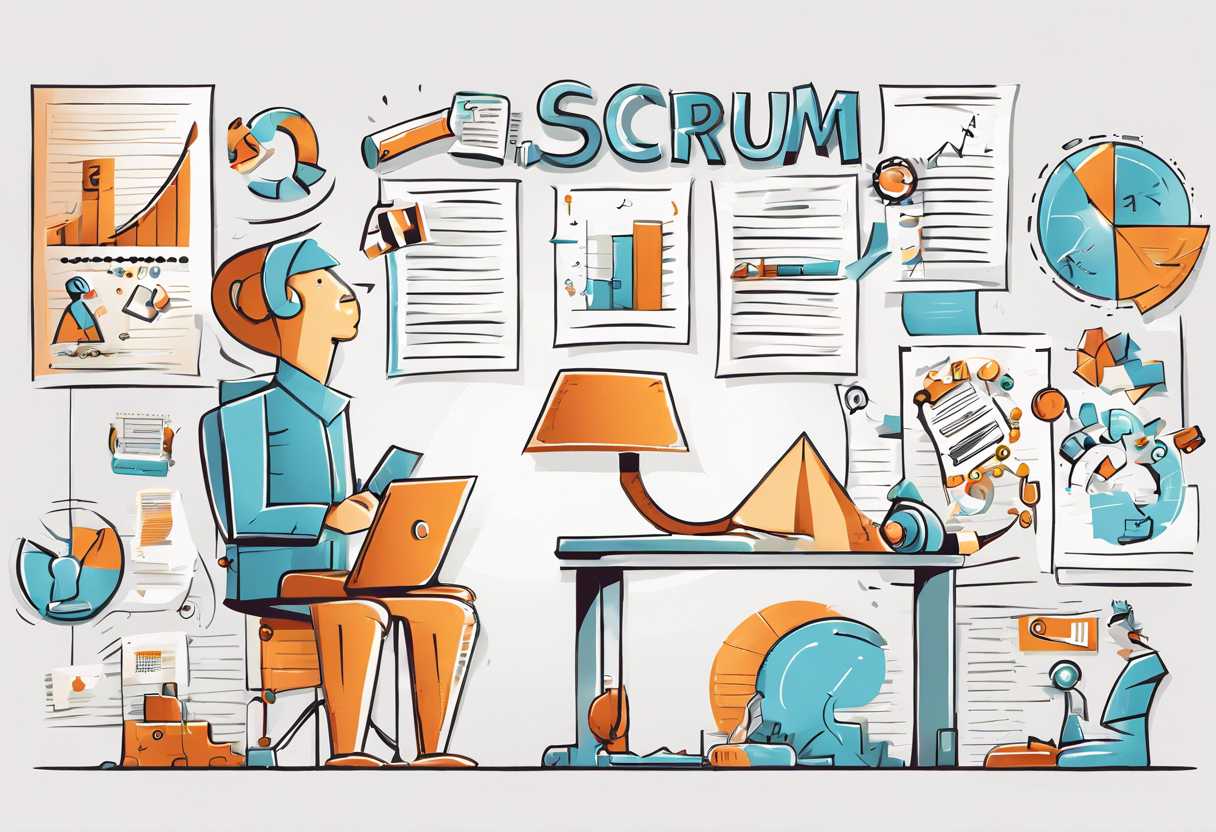Are you looking to gain a deeper understanding of the fundamental principles of agile and scrum-plus? In this blog post, we will explore the key differences in methodology and approach between these two popular project management frameworks. By comparing the flexibility and adaptability of agile and scrum-plus, we aim to provide insights into their respective strengths and weaknesses. Additionally, we will unpack the roles and responsibilities within agile and scrum-plus teams, as well as evaluate their impact on project management success. Join us as we delve into the world of agile and scrum-plus to gain a comprehensive understanding of their unique features and applications.
Understanding the Fundamental Principles of Agile and Scrum-Plus
The Agile Methodology: A Paradigm Shift in Project Management
Agile methodology is a revolutionary approach to project management that emphasizes flexibility, collaboration, and customer satisfaction. Unlike traditional waterfall methods, Agile focuses on iterative development, allowing for continuous improvement and adaptation to changing requirements. This approach enables teams to deliver high-quality products more efficiently, making it a popular choice for software development and other industries.
The Core Principles of Scrum-Plus
Scrum-Plus is an extension of the Agile framework that incorporates additional practices to enhance project management. At its core, Scrum-Plus emphasizes the importance of self-organization, cross-functional teams, and regular feedback loops. By integrating these principles, Scrum-Plus aims to optimize productivity, minimize risks, and deliver value to stakeholders in a timely manner.
Key Differentiators of Agile and Scrum-Plus
One of the key differentiators between Agile and Scrum-Plus is the level of structure and formality. While Agile provides a flexible framework for iterative development, Scrum-Plus adds specific guidelines and practices to streamline the process further. Additionally, Scrum-Plus places a strong emphasis on continuous improvement and adaptability, making it well-suited for complex and dynamic projects.

Exploring the Key Differences in Methodology and Approach
Traditional vs. Agile Methodology
When it comes to project management, traditional and Agile methodologies are two of the most commonly used approaches. Traditional methodology follows a linear, sequential approach, where each phase of the project is completed before moving on to the next. On the other hand, Agile methodology is iterative and flexible, allowing for continuous improvement and adaptation throughout the project lifecycle. While traditional methodology is best suited for projects with well-defined requirements and minimal changes expected, Agile methodology is ideal for projects with evolving requirements and a need for frequent feedback and collaboration.
Waterfall vs. Spiral Approach
The Waterfall and Spiral approaches are two distinct models used in software development. The Waterfall approach follows a linear and sequential process, with each phase dependent on the deliverables of the previous phase. In contrast, the Spiral approach is iterative and incorporates elements of both Waterfall and Agile methodologies, allowing for risk analysis and prototyping in each cycle. While the Waterfall approach is best suited for projects with stable requirements and minimal changes expected, the Spiral approach is ideal for projects with high levels of uncertainty and a need for risk management and early prototyping.
Comparing Feature-Based and Time-Based Ranking
When it comes to search engine optimization (SEO), feature-based and time-based ranking are two common approaches used to prioritize search results. Feature-based ranking considers the relevance and quality of content, user engagement, and other factors to determine the ranking of search results. On the other hand, time-based ranking prioritizes the recency of content, giving preference to newer posts or updates. While feature-based ranking is ideal for evergreen content and long-term visibility, time-based ranking is suitable for trending topics and current events.

Comparing the Flexibility and Adaptability of Agile and Scrum-Plus
Flexibility in Agile and Scrum-Plus
Agile and Scrum-Plus are both known for their flexibility in adapting to changing requirements and priorities. Agile emphasizes the ability to respond to change over following a plan, while Scrum-Plus incorporates the flexibility of Agile with the added structure of a project management framework. Both methodologies allow for iterative development and continuous improvement, enabling teams to adjust their approach based on feedback and evolving business needs.
Adaptability in Agile and Scrum-Plus
When it comes to adaptability, Agile and Scrum-Plus differ in their approach. Agile focuses on empowering teams to self-organize and make decisions, allowing for quick adjustments and course corrections. On the other hand, Scrum-Plus provides a more structured framework with defined roles, ceremonies, and artifacts, which can enhance adaptability by providing clear guidelines and processes for managing change. This can be particularly beneficial for larger or more complex projects where a higher level of structure is needed to ensure adaptability without sacrificing control.
Comparison Table: Flexibility and Adaptability
| Agile | Scrum-Plus | |
| Flexibility | Emphasizes responding to change over following a plan | Incorporates flexibility with added structure for project management |
| Adaptability | Empowers teams to self-organize and make decisions | Provides a structured framework with defined roles, ceremonies, and artifacts |
Overall, both Agile and Scrum-Plus offer flexibility and adaptability, but they do so in different ways. The choice between the two methodologies will depend on the specific needs and constraints of the project, as well as the preferences and capabilities of the team.
Roles and Responsibilities in Agile and Scrum-Plus Teams
The Scrum Framework
In the Scrum framework, there are three primary roles: the Product Owner, the Scrum Master, and the Development Team. The Product Owner is responsible for defining the features of the product, deciding on release dates, and prioritizing the work that needs to be done. The Scrum Master is responsible for ensuring that the Scrum process is followed and facilitating communication between the Product Owner and the Development Team. The Development Team is responsible for delivering potentially shippable increments of the product at the end of each sprint.
Agile Team Roles
Agile teams typically consist of a Product Owner, a Scrum Master, and the Development Team, similar to the Scrum framework. However, in Agile teams, there is often a greater emphasis on collaboration and self-organization. The Product Owner is responsible for defining the product vision and prioritizing the work, while the Scrum Master is responsible for coaching the team and removing any obstacles that may impede their progress. The Development Team is responsible for delivering high-quality, working software at the end of each iteration.
Scrum-Plus Team Roles
In a Scrum-Plus team, there may be additional roles beyond the traditional Product Owner, Scrum Master, and Development Team. These additional roles could include a Business Analyst, a Quality Assurance Specialist, or a User Experience Designer. Each of these roles brings a unique perspective and skill set to the team, helping to ensure that the product meets the needs of both the business and the end users.
Evaluating the Impact of Agile and Scrum-Plus on Project Management Success
Agile and Scrum-Plus: Understanding the Basics
Agile and Scrum-Plus are two popular project management methodologies that have gained significant traction in recent years. Agile focuses on iterative development and collaboration, while Scrum-Plus is an extension of Scrum that incorporates additional practices for managing complex projects. Both methodologies aim to improve project flexibility, adaptability, and customer satisfaction.
The Impact of Agile and Scrum-Plus on Project Success
Research has shown that organizations that adopt Agile and Scrum-Plus methodologies experience several benefits, including improved project delivery speed, enhanced team collaboration, and increased customer satisfaction. These methodologies also promote transparency, adaptability, and continuous improvement, leading to higher project success rates and overall business performance.
Key Differences and Considerations
While both Agile and Scrum-Plus offer valuable tools and practices for project management, it’s essential to understand their differences and consider the specific needs of your organization. Agile is more focused on flexibility and customer collaboration, while Scrum-Plus provides a more structured framework for managing complex projects. Organizations should carefully evaluate their project requirements and team dynamics to determine which methodology is the best fit.
Conclusion
As we conclude our exploration of the differences between agile and scrum-plus, it’s clear that both methodologies offer unique approaches to project management. Understanding the fundamental principles of agile and scrum-plus is essential for organizations looking to adopt the most suitable methodology for their projects.
Exploring the key differences in methodology and approach has highlighted the distinct characteristics of agile and scrum-plus, from their iterative nature to their focus on adaptability and collaboration.
Comparing the flexibility and adaptability of agile and scrum-plus has revealed the varying degrees of structure and freedom that each methodology provides, catering to different project requirements and team dynamics.
Unpacking the roles and responsibilities in agile and scrum-plus teams has shed light on the unique dynamics and interactions that drive the success of each methodology, emphasizing the importance of clear communication and collaboration.
Evaluating the impact of agile and scrum-plus on project management success has underscored the significance of choosing the right methodology to maximize efficiency, productivity, and overall project outcomes.
As organizations continue to navigate the complexities of project management, it’s crucial to consider the nuances of agile and scrum-plus to make informed decisions that align with their specific needs and goals. Whether it’s embracing the adaptability of agile or the structure of scrum-plus, the key is to leverage the strengths of each methodology to drive successful project delivery.
Ultimately, the choice between agile and scrum-plus should be guided by a deep understanding of their principles, methodologies, and impact on project management. By doing so, organizations can empower their teams to work more effectively, collaborate more seamlessly, and achieve greater project success.
Thank you for joining us on this journey of discovery. We hope this exploration has provided valuable insights and guidance as you navigate the world of agile and scrum-plus.

